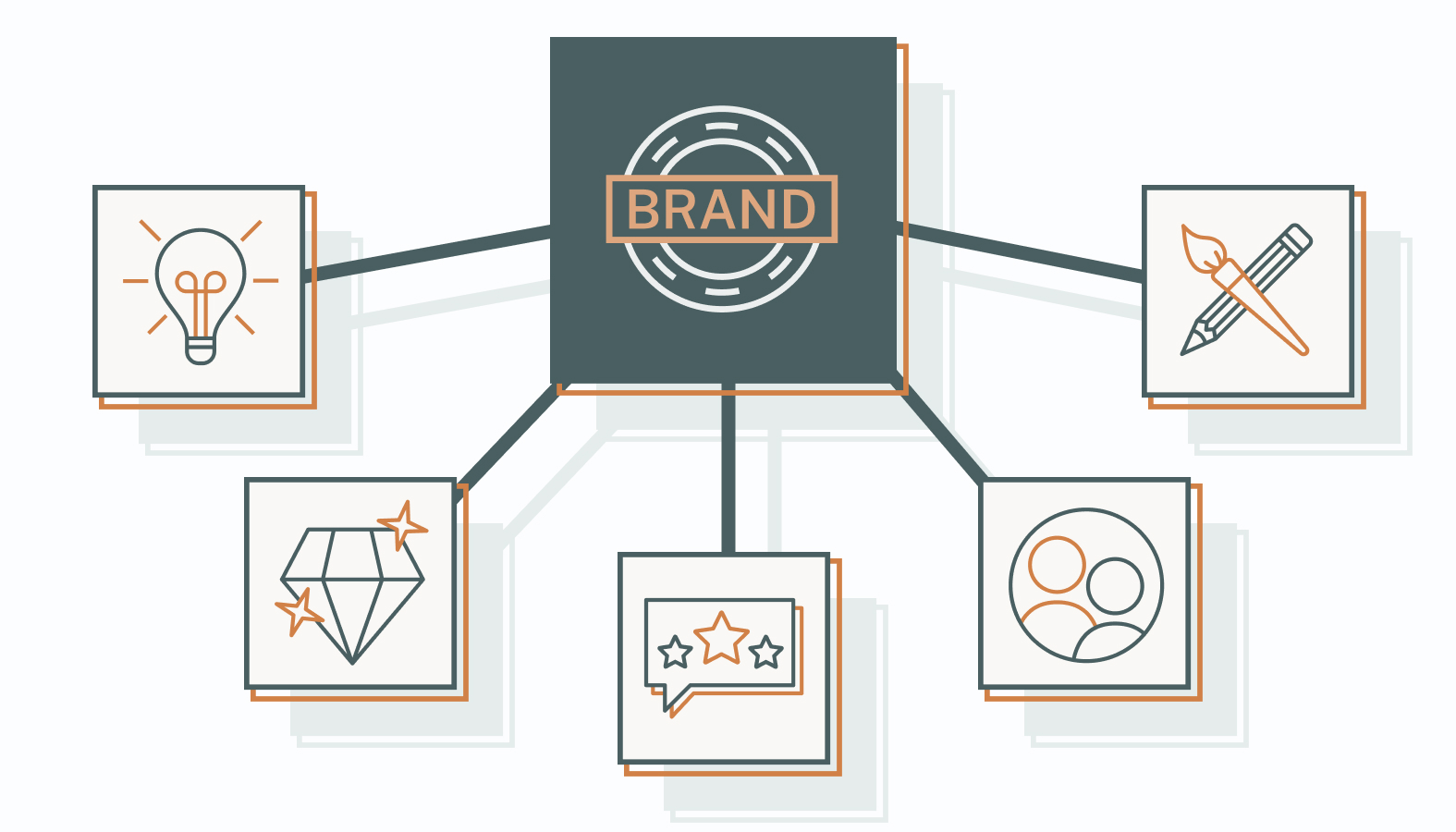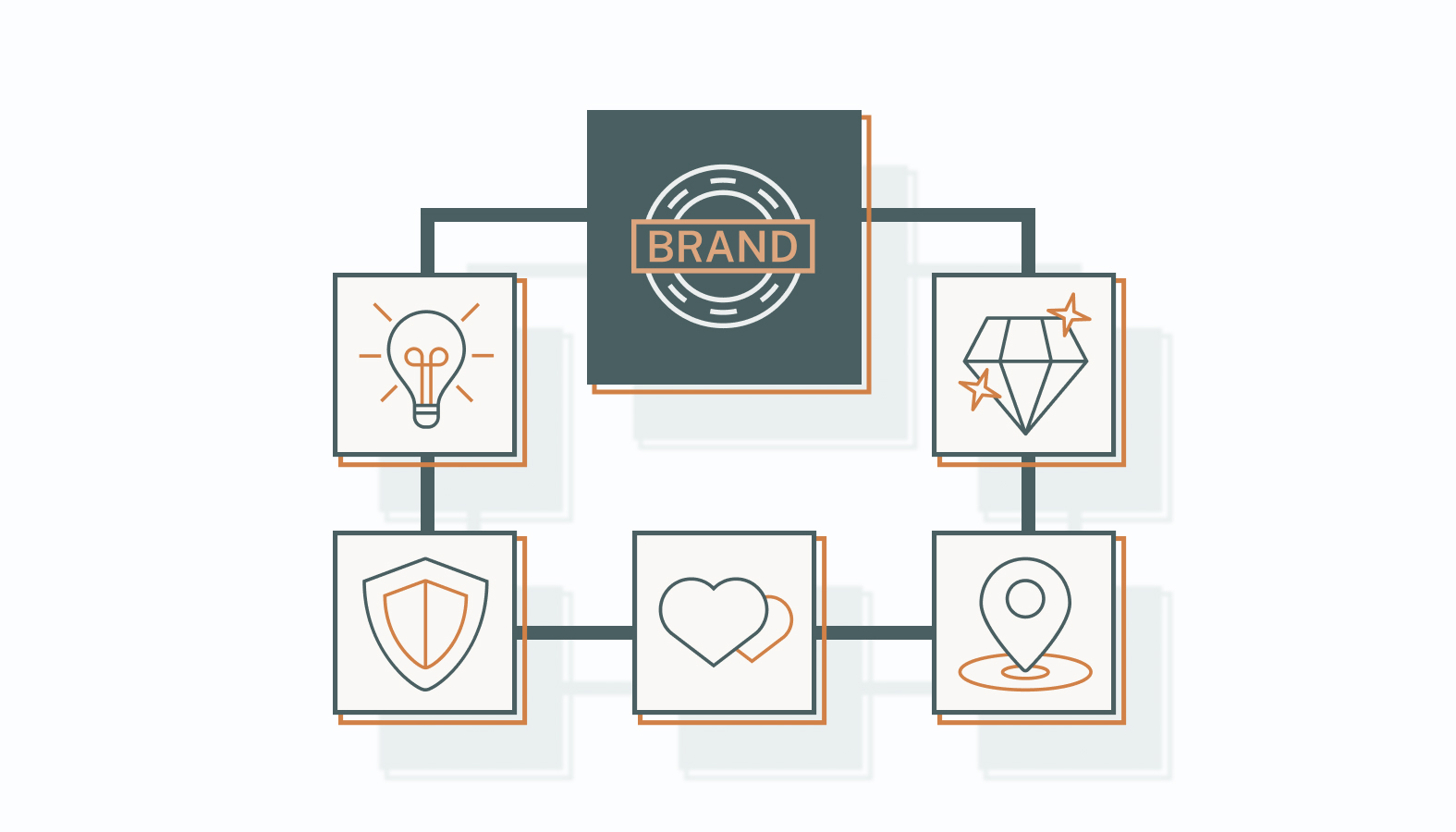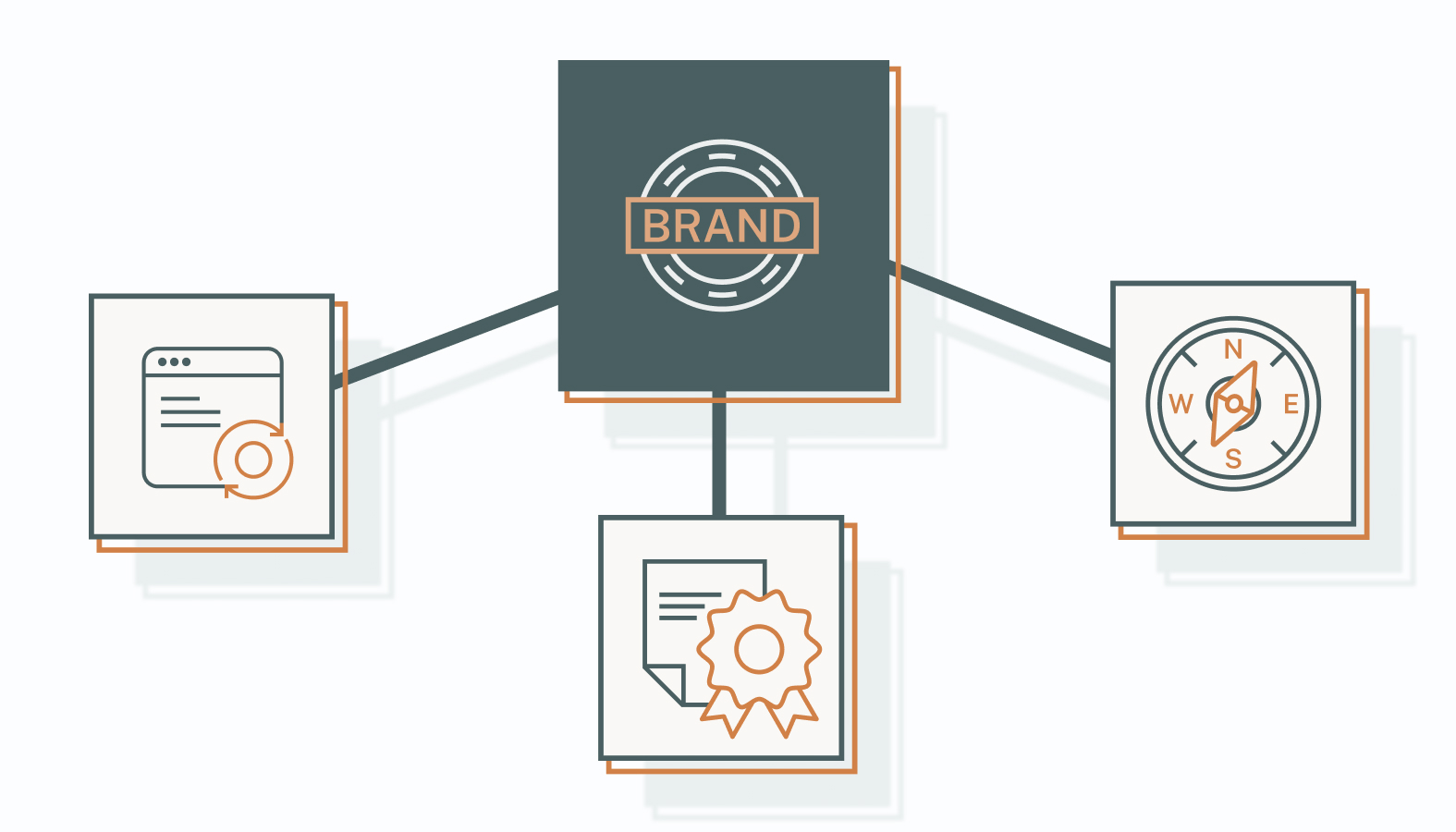A brand is an intricate puzzle. Each piece—the logo, packaging, personality, and colors—forms the initial impression while the stories, values, and connections it evokes complete the picture.
Together, these elements create a powerful brand experience that touches every point of consumer interaction.
Effective brand marketing turns regular products into icons and positions companies as leaders in their industry.
This post explains the intersection of branding and promotion, demonstrating how the two disciplines—when synchronized—can dramatically optimize customer engagement and loyalty, transforming buyers into champions of your brand.
Unpacking the Concept of a Brand
A brand is more than what meets the eye. It’s a powerful blend of tangible and intangible elements that create a unique identity in the consumer’s mind.
- The Tangible Stage: Think of logos, packaging, products, and color palette as the opening act. These visual cues define brand recognition, helping consumers notice you in a crowded marketplace.
- The Intangible Powerhouse: But the real magic lies in the emotions and connections a brand evokes. These are the brand’s promises, values, and experiences. It’s the brand’s story that breathes life into your product or service, making it relatable and memorable.
- The Holistic Harmony: Together, these tangible and intangible aspects create a symphony of brand experience. It becomes how you speak, act, and present yourself every time you engage with your target audience.
Understanding this full spectrum is crucial in today’s digital age, where competitors are a click away.
The Intersection of Branding and Marketing
Brand management and marketing are two different concepts, but both are necessary in business.
Branding is the art of defining and shaping a brand’s identity. It crafts a compelling narrative that resonates with an audience.
Marketing is the strategy of promoting and selling products or services. Market research, advertising, distribution, and other techniques are used to achieve business goals.
Effective marketing campaigns communicate a brand’s identity clearly and consistently across all platforms. Every marketing effort should echo the brand’s core message through social media posts, TV ads, or promos. This consistency reinforces the brand’s identity in consumers’ minds, so they likely remember and choose to believe in your brand over others.
The intersection of these two is where the magic happens.
Branding sets the stage, and marketing performs upon it. When branding and marketing harmonize, their powerful combination captivates an audience, turning casual consumers into loyal advocates.
The Anatomy of an Effective Brand
A brand’s core attributes set it apart from its rivals. These attributes dictate how the brand engages with its audience and shape every aspect of its marketing approach.
Incorporating these fundamental attributes guarantees authentic, impactful, and successful marketing campaigns.
Core Values and Mission
Forget hollow mission statements. Authentic core values are the compass guiding your brand marketing tactics.
Core values aren’t just words on paper. They’re the driving force behind every marketing message and customer interaction.
Align your marketing with your core values, and your brand voice will resonate deeper. It transcends transactions, cultivating genuine connections with your audience.
Marketing becomes a platform to showcase your commitment. As a result, you attract customers who want to join a movement rather than just buy a product.
Brand Personality and Voice
A distinct brand voice and personality are magnets, attracting your target audience. Consistency across every marketing platforms is key to building recognition and rapport. Your personality should shine through every message, image, and interaction.
Imagine your brand as a character, speaking directly to your audience’s hearts and minds.
Clarity and consistency in voice and personality make customer connection effortless. This consistency and cohesive brand identity fosters trust. It creates a familiar voice your customers can quickly identify with.
Brand Positioning and Promise
Effective marketing requires brand promise and positioning.
Positioning carves out your unique space in the market. It tells your story: who you are, what you serve, and why you matter.
Meanwhile, brand promise refers to the benefit your product/service offers and how it solves a specific problem for the customer.
Combine both elements into statements, taglines, and all your messaging, so you always convey what your brand stands for.
Marketing translates this promise into action. Every touchpoint–from advertising to packaging to digital content–reminds customers why you’re their perfect choice.
The promise sets expectations, and marketing delivers.
Brand Experience and Storytelling
Storytelling in marketing is a strategic tool. Facts and figures tell; stories sell.
Well-crafted stories spark emotions, convey overall brand values, and enrich the customer experience.
Marketing that weaves a narrative informs, entertains, and enlightens. Through stories, brands share their heritage, celebrate customer wins, and showcase values in action.
Build marketing campaigns that highlight customer aspirations, challenges, and triumphs, allowing them to see themselves in your story.
Storytelling deepens emotional bond, making your brand a part of theirs.
Brand Equity: The Measure of Brand Strength
Brand equity is more than just a name. It’s the premium value consumers place on your brand compared to generic alternatives. This value stems from perception, not the product itself.
High brand equity makes you a market leader, the trusted choice. It’s a key metric for brand success, reflecting overall strength and market position.
Components of Brand Equity
Brand equity means understanding what makes your brand valuable to consumers and the market as a whole. It empowers your brand to command customer loyalty and justify premium pricing.
The following brand equity components include:
Brand Awareness
Brand awareness refers to the degree to which consumers recognize a brand. It measures how familiar the public is with a brand’s name, visuals, or associations. Simply put, how easily does your brand come to mind?
High brand awareness puts your brand at the forefront of potential buyers’ minds for your category. It’s the crucial first step in building brand equity. It lays the foundation for stronger brand connections.
Brand Associations
Brand associations refer to what your brand means to your audience. Consumers automatically link these qualities, beliefs, and values to your brand.
Brand associations stem from product features, benefits, or the lifestyle your brand represents.
Positive associations, like high quality, innovation, or excellent service, significantly impact brand equity. They shape consumer perception and influence buying decisions.
Perceived Quality
Perceived quality refers to how good customers think you are. It’s about your customers’ subjective experience–how they judge your product or service against the competition.
High perceived quality fuels brand equity by driving customer satisfaction, loyalty, and repeat purchases. Customers are happy to pay more, and brands can expand their market share.
Brand Loyalty
Brand loyalty is the heart of brand equity. Your biggest fans drive sales and sing praises.
Loyal customers consistently choose your brand over competitors. This deep commitment results in consistent revenue and free word-of-mouth marketing.
Brand Assets
Brand assets refer to tangible and intangible resources linked to a brand. These include trademarks, designs, patents, and copyrights – all the things that make your brand unique. They’re legally protected, stopping others from copying your identity.
Brand property are crucial for brand equity. They secure your exclusive rights and boost the overall perception of your brand’s value.
Fostering the Brand-Consumer Relationship
In today’s business environment, brands get to the top by cultivating relationships with their customers.
This brand-consumer relationship doesn’t happen overnight; It develops gradually when companies focus on the following activities:
Provide Exceptional Customer Service
Exceptional customer service is your frontline for building brand loyalty. It’s a chance to show you care (customer satisfaction), live your values, and fix issues before they hurt your reputation.
Consistent attentiveness, helpfulness, and empathy establish trust and reliability. All these combined turn one-time buyers into long-term advocates.
Engage Through Social Media
Social media is the go-to platform for ditching corporate speak and engaging with customers on a personal level.
Engagement through these channels allows a brand to humanize itself. Share relatable content, spark conversations, and actively listen. It’s a two-way street that makes each customer feel valued.
Create a Loyalty Program
Loyalty programs are a win-win for you and your customers.
Companies incentivize customers’ continuous engagement and repeat business with perks like discounts and early access.
Loyalty programs show customers you value their business. These encourage ongoing commitment and positive brand sentiment.
Deliver Consistent and High-Quality Products/Services
Quality is the foundation of trust.
Customers trust brands that deliver high-quality products and services consistently.
When customers know brands can meet and exceed expectations every time, it paves the way for a strong, lasting relationship.
Use Customer Feedback to Improve
Listen, learn, improve… it’s the customer feedback loop that strengthens brands.
Actively seeking and using customer feedback shows your commitment to improvement. Surveys, reviews, and direct engagement provide insights into what works and where to improve.
When tangible changes are made based on feedback, it tells customers you value their opinions. You prove dedication to their needs, and in return, they strengthen their commitment to your brand.
Foster Community
A sense of community enhances the bond between consumers and the brand. This is where customers become your brand’s advocates.
By creating communities, online or offline, you give customers a place to share experiences and stories.
Engaged communities become brand ambassadors. They organically promote you to both current and potential customers.
The Pivotal Role of Branding in Business
Branding is the DNA and lifeblood of any business. It shapes every interaction, decision, and long-term strategy.
Strong branding makes you stand out, connect with customers, and win in a crowded market.
Identity and Recognition
Think of brand identity as your company’s signature. It reflects your values, culture, and aspirations.
Powerful brand identity isn’t random. It’s carefully crafted to ensure visibility and recognition. It guides customers in a crowded market, making sure they know why you’re the perfect choice.
Trust and Credibility
Powerful brands build trust and credibility.
Consistent quality, reliability, and actions all establish trust. Effective branding communicates these values, earning trust from customers, investors, and partners.
Credibility stems from a proven track record, integrity, and delivering on promises.
Trust and credibility unlock growth, attract investment, and solidify customer loyalty.
Emotional Connection
Effective branding aims to build an emotional bond with consumers. Storytelling, aesthetics, and values all play a part.
Great branding connects with customers on an emotional level, not just through product features. Customers who see themselves in your brand become loyal and return for more.
This emotional connection creates resilience that withstands price wars and market shifts.
Differentiation and Positioning
In a competitive landscape, strong brands stand out.
Branding creates a unique market position, differentiating you beyond products. Customers relate to your brand through your narrative, promise, and experience.
Clear positioning helps customers choose you for their specific needs.
Value Perception
Consumers judge by perception.
Branding significantly influences the perceived value of a business’s products or services. It makes ordinary products highly desirable.
Strong branding justifies premium pricing. It allows you to charge a premium price and create a perception of exclusivity, making your product or service more valuable than just its cost.
This strategic approach can influence the competitive landscape, shaping market perceptions of similar products within a category.
Brand Marketing Missteps to Avoid
Marketing missteps can erode trust. Protect your brand reputation by avoiding missteps such as:
Temptation to Greenwash
Greenwashing describes the deceptive practice of misleading consumers about a company’s environmental practices. Examples include vague claims, exaggerated benefits, or outright fabrication about a product’s eco-friendliness.
As sustainability gains importance, transparency is key. Don’t mislead consumers about your company’s eco-friendliness. Deceptive claims risk backlash, lost trust, and legal trouble.
Building a sustainable brand requires authenticity. Sustainability efforts should be backed by verifiable actions. Be honest about your environmental initiatives, and back it up with real action. That’s how you build your brand with staying power.
Forced Virtue Signaling
Consumers today expect brands to be genuine in their social and environmental stances.
Virtue signaling occurs when a brand attempts to take a stand in a way that feels inauthentic. When a brand isn’t genuine about its values, it can backfire and affect sales.
The key to authenticity is to align actions with brand values.
If you speak up on important issues, take concrete steps to contribute. Partner with relevant organizations. Champion meaningful legislation. Most importantly, implement changes within your own company.
This sincerity builds respect and trust with consumers.
Relying Too Heavily on Trends
Following trends can keep you relevant, but don’t get swept away. Chasing fads risks diluting your brand identity and confusing customers.
Focus on long-term brand building. Evolve, but stay true to your core. Loyal customers value consistency.
Three Pillars of Effective Brand Marketing
Brand marketing thrives on three pillars: consistency, authenticity, and adaptability. Together, these elements project a clear, unwavering brand image.
1. Consistency
Consistency in brand marketing equals strong brand recognition.
Consistently include your brand message with every interaction. Repetition establishes trust and fosters brand recognition, establishing your brand as a dependable choice in consumers’ minds.
2. Authenticity
In today’s saturated market, authenticity is king. It means staying true to your values, speaking with a genuine tone of voice, and acting with integrity.
Authenticity in marketing means knowing who you are as a brand and living it out loud. A brand’s honest messaging builds trust and loyalty because consumers see through facades.
3. Adaptability
Adaptable marketing acknowledges that consumer behavior, market conditions, and technology constantly shift.
Brands must be agile to navigate the ever-evolving market landscape.
Successful brands adapt strategies while maintaining their core identity. Proactive innovation ensures continued relevance and competitiveness.
Brands that adapt quickly win, no matter what the target market throws their way.
Your Next Steps in Brand Marketing Mastery
The key to successful brand marketing is a good mix of art and science.
Building a brand that resonates, engages, and endures in consumers’ hearts is no small feat. It requires insight, patience, and a strategic touch that only comes with experience.
Ready to take the next step?
Our experts are more than happy to share their knowledge with you in a genuine conversation. Let’s talk about a strong brand marketing strategy – authentically and confidentially.
Feel free to schedule a candid conversation with one of our experts » and dive into the world of brand marketing with guidance you can trust.
Let’s connect and explore how our strong brand marketing expertise can illuminate your brand’s brightest potential.











